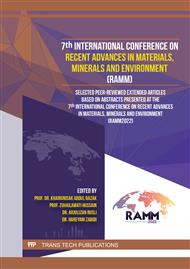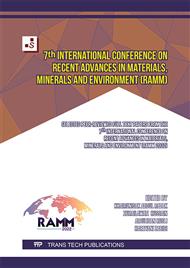[1]
M. Safiuddin, A.B.M. Amrul Kaish, C.-O. Woon, S.N. Raman, Early-age cracking in concrete: causes, consequences, remedial measures, and recommendations, Appl. Sci. 8 (2018) 1730.
DOI: 10.3390/app8101730
Google Scholar
[2]
L. Czarnecki, R. Geryło, K. Kuczyński, Concrete repair durability, Materials 13 (2020) 4535.
DOI: 10.3390/ma13204535
Google Scholar
[3]
A. Idrus, S.A. Farhan, C.S. Choo, N. Ismail, Structural performance of impact-damaged reinforced concrete beams after patch repair with SBR polymer-modified cementitious mortar, International Journal of Advances in Mechanical and Civil Engineering 3 (2016) 51–55.
Google Scholar
[4]
H. Saleem, S.J. Zaidi, N.A. Alnuaimi, Recent advancements in the nanomaterial application in concrete and its ecological impact, Materials 14 (2021) 6387.
DOI: 10.3390/ma14216387
Google Scholar
[5]
F.I. Ismail, S.A. Farhan, N. Shafiq, N. Husna, M.T. Sharif, S.U. Affan, A.K. Veerasenan, Nano-porous silica-aerogel-incorporated composite materials for thermal-energy-efficient pitched roof in the tropical region, Appl. Sci. 11 (2021) 6081.
DOI: 10.3390/app11136081
Google Scholar
[6]
M.F. Khamidi, C. Glover, S.A. Farhan, N. Husna, M.F. Nuruddin, Effect of silica aerogel on the thermal conductivity of cement paste for the construction of concrete buildings in sustainable cities, in: W.P. De Wilde, S. Hernández, C.A. Brebbia (Eds.), High Performance and Optimum Design of Structures and Materials, WIT Press, Southampton, UK, 2014, p.665–674.
DOI: 10.2495/hpsm140601
Google Scholar
[7]
B.P. Vinayan, Heteroatom-doped graphene-based hybrid materials for hydrogen energy conversion, Recent advances in graphene research. London, UK: InTech, (2016) 177–194.
DOI: 10.5772/64242
Google Scholar
[8]
S. Panda, T.K. Rout, A.D. Prusty, P.M. Ajayan, S. Nayak, Electron transfer directed antibacterial properties of graphene oxide on metals. Adv. Mater. 30 (2018) 1702149.
DOI: 10.1002/adma.201702149
Google Scholar
[9]
S. Korkmaz, İ.A. Kariper, Graphene and graphene oxide based aerogels, synthesis, characteristics and supercapacitor applications. J. Energy Storage. 27 (2020) 101038.
DOI: 10.1016/j.est.2019.101038
Google Scholar
[10]
Y. Qian, I.M. Ismail, A. Stein, Ultralight, high-surface-area, multifunctional graphene-based aerogels from self-assembly of graphene oxide and resol. Carbon. 68 (2014) 221–231.
DOI: 10.1016/j.carbon.2013.10.082
Google Scholar
[11]
C. Liu, X. Huang, Y.-Y., Wu, X. Deng, Z. Zheng, Z. Xu, D. Hui, Advance on the dispersion treatment of graphene oxide and the graphene oxide modified cement-based materials, Nanotechnol. Rev. 10 (2021) 34-49.
DOI: 10.1515/ntrev-2021-0003
Google Scholar
[12]
F.I. Ismail, Y.M. Abbas, N. Shafiq, G. Fares, M. Osman, L.A. Hussain, M.I. Khan, Investigation of the impact of graphene nanoplatelets (GnP) on the bond stress of high-performance concrete using pullout testing, Materials 14 (2021) 7054.
DOI: 10.3390/ma14227054
Google Scholar
[13]
W. Baomin, D. Shuang, Effect and mechanism of graphene nanoplatelets on hydration reaction, mechanical properties and microstructure of cement composites, Constr. Build. Mater. 228 (2019) 116720.
DOI: 10.1016/j.conbuildmat.2019.116720
Google Scholar
[14]
Y. Zhao, Y. Liu, T. Shi, Y. Gu, B. Zheng, K. Zhang, J. Xu, Y. Fu, S. Shi, Study of mechanical properties and early-stage deformation properties of graphene-modified cement-based materials, Constr. Build. Mater. 257 (2020) 119498.
DOI: 10.1016/j.conbuildmat.2020.119498
Google Scholar
[15]
F.I. Ismail, S.A. Farhan, N. Husna, N. Shafiq, M.M. Abdul Wahab, S.N. Abd Razak, Influence of graphene nanoplatelets on the compressive and split tensile strengths of geopolymer concrete, IOP Conf. Ser. Earth Environ. Sci. 945 (2021) 012060.
DOI: 10.1088/1755-1315/945/1/012060
Google Scholar
[16]
Z. Jiang, M.M. Sherif, G. Xing, O.E. Ozbulut, Tensile characterization of graphene nanoplatelets (GNP) mortar using acoustic emissions, Mater. Today Commun. 25 (2020) 101433.
DOI: 10.1016/j.mtcomm.2020.101433
Google Scholar
[17]
ASTM C192: Standard Practice for Making and Curing Concrete Test Specimens in the Laboratory, ASTM International, PA, USA, 2019.
Google Scholar
[18]
ASTM C470: Standard Specification for Molds for Forming Concrete Test Cylinders Vertically, ASTM International, PA, USA, 2015.
Google Scholar
[19]
ASTM C39: Standard Test Method for Compressive Strength of Cylindrical Concrete Specimens, ASTM International, PA, USA, 2021.
Google Scholar



